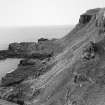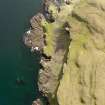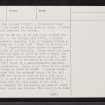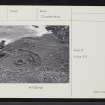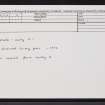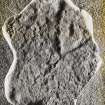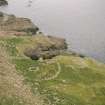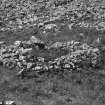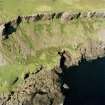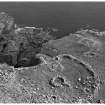Following the launch of trove.scot in February 2025 we are now planning the retiral of some of our webservices. Canmore will be switched off on 24th June 2025. Information about the closure can be found on the HES website: Retiral of HES web services | Historic Environment Scotland
Canna, Sgorr Nam Ban-naomha
Monastic Settlement (Early Medieval)(Possible)
Site Name Canna, Sgorr Nam Ban-naomha
Classification Monastic Settlement (Early Medieval)(Possible)
Alternative Name(s) Skerry Of The Holy Women; 'cashel'; 'nunnery'; 'the Altar'
Canmore ID 10766
Site Number NG20SW 2
NGR NG 22991 04395
Datum OSGB36 - NGR
Permalink http://canmore.org.uk/site/10766
- Council Highland
- Parish Small Isles
- Former Region Highland
- Former District Lochaber
- Former County Inverness-shire
This remote enclosed site is situated on a coastal terrace below steep cliffs. Probably of monastic origin, it may have been a hermitage or penitential station associated with an Early Christian church at nearby Canna Harbour. Survey by the RCAHMS in 1994 discovered three carved stones, bearing crosses, within the enclosure.
Information from RCAHMS (SC) 7 August 2007
RCAHMS Broadsheet 5, Canna, The Archaeology of a Hebridean Landscape
Rubha Sgor nam Ban Naomha (cliff of the holy women) Relics of what appears to have been a hermitage or offshoot of the Keill monastery lying undisturbed on a grassy ledge, reached only by a treacherous path on Canna's southern cliffs. Described as a Celtic nunnery or cashel, this oval enclosure is believed to have been occupied from the 7th century until the Reformation. Evidence survives of an intriguing water drainage system.
Taken from "Western Seaboard: An Illustrated Architectural Guide", by Mary Miers, 2008. Published by the Rutland Press http://www.rias.org.uk
Sgor nam Ban-Naomha 1, Canna, Skye & Lochalsh, cross-slab fragment
Measurements: H 0.25m, W 0.13m, D 0.04m
Stone type: Torridonian sandstone
Place of discovery: NG 2299 0439
Present location: Canna House.
Evidence for discovery: found during RCAHMS fieldwork in 1993-4, in the ruins of a stone-built hut.
Present condition: broken and weathered.
Description
This fragment represents the central portion of a small cross-slab carved in relief with a cross with curved armpits and a central hollow.
Date range: eighth or ninth century.
Primary references: Fisher 2001, 101.
Compiled by A Ritchie 2016
Sgor nam Ban-Naomha 3, Canna, Skye & Lochalsh, cross-slab fragments
Measurements: H 0.38m, W 0.35m, D 0.04m
Stone type: Torridonian sandstone
Place of discovery: NG 2299 0439
Present location: Canna House.
Evidence for discovery: found during RCAHMS fieldwork in 1993-4, in the ruins of a stone-built hut.
Present condition: broken and weathered.
Description
These two conjoining fragments form the top left and central portion of a rectangular cross-slab. It is incised on one broad face with the upper arm and ring segments of a ringed outline cross.
Date range: eighth or ninth century.
Primary references: Fisher 2001, 101.
Field Visit (4 July 1925)
Cashel (?) Sgor nam Ban–naomha ("Skerry of the Holy Women").
The southern coast of Canna is precipitous and indented, presenting to the sea a bulwark of upper and lower cliffs separated by a steep grassy slope, which rises in most places from a terrace. One of these terraces, situated at a very exposed part of the coast about 2 ¼ miles west of the bridge connecting Sanday with Canna, bears the remains of what may be a Cashel or monastic settlement of Celtic type; the place-name of the cliff beneath which it lies is, in English, "the skerry of the holy women", and it is inferred that the establishment was a nunnery. The site is peculiarly remote, basaltic escarpments effectually isolating it from the landward, while access from the sea is only possible in the finest weather. The terrace is covered with turf, is 50 to 70 yards in breadth and is fairly level; it is strewn with detritus of the upper cliff, which has afforded a convenient building material. The construction consists of an enclosure about 40 yards in diameter formed by a wall of drystone building 5 feet in thickness, the entrance lying on the southern, the seaward side; in the construction of this wall advantage has been taken of rock outcrops and fallen boulders to economise labour, and on this account the shape is irregular, rather ear-shaped than circular.
Within the enclosure (Fig. 307) four structures are built against the outer wall, and there are three others free-standing, while a dense growth of bracken possibly conceals the remains of others. The masonry is built dry throughout.
Without excavation little can be said of the buildings, but two of the structures reared against the outer wall were respectively the well-house and the mill. Within the former a spring rises in a basin of masonry, and there is also an external access to the well, possibly secondary. The water runs southward in a surface channel, then dips below ground to reappear in the bottom of the mill-house, where it is joined by another spring entirely subterranean. The mechanism of the mill probably resembled that of the horizontal mills of Shetland (1), and the mill-house is similar in type to one on the island of Taransay, Harris (NB00SW 3) ; in the upper part is an aumbry, a feature found in the north-western structure also.
The largest and most complete of the freestanding buildings stands near the centre of the enclosure; it is two chambered. The larger chamber is some 16 feet in diameter within walls 3 feet in thickness, and is built of larger stones than the other structures. Of equal dimensions is a single chambered structure next the mill, which is D-shaped on plan; within it is a low circular platform, either building or debris supporting a low rectangular erection containing a number of stone pounders and a fragment of a saddle quern. This is marked on the O.S. map as ‘Old Altar’ (2).
(1) Proc. Soc. Ant. Scot., XX., p. 257, footnote. (2) Cf. Ibid., XXXIII., p. 133.
RCAHMS 1928, visited 4 July 1925.
OS map: Islands of Canna and Sanday (Inverness-shire) lix.
Field Visit (15 August 1963)
Field Visit (23 May 1972)
A cashel at NG 2299 0433 at the foot of a cliff named Sgor nam Ban-naomha. The precinct wall averages 1.8m in thickness and encloses a sub-oval area measuring 39.0m N-S by 32.0m. Details of the entrance in the S are obscured by debris.
The main building in the interior ('A' on plan) is a strong dry built circular structure near the centre, stated by RCAHMS to be two-chambered. It measures 4.8m in diameter within a wall averaging 1.3m thick and surviving to a maximum height of 1.4m. The entrance seems to have been in the W where the wall has partially collapsed. Outside this entrance and built against the wall are the footings of a sub-circular annexe of much slighter construction, which may be secondary. It measures c.3.0m in diameter within a ruined wall spread to 1.5m.
Structure 'B' is too ruinous to interpret its true plan, but its inner face appears to be circular giving an internal diameter of 4.8m within a wall about 1.0m thick. There is an ill-defined entrance in the W. In the interior is the alleged 'altar', a rectangular area 3.0m N-S by 2.2m formed by thin slabs on edge. A modern heap of debris occupies its centre.
Abutting onto the SE arc of 'B' and built against the precinct wall, is the alleged mill ('C'), a roughly circular dry-built structure 1.9m in diameter within a wall 0.7m thick and c.1.0m high. There is no trace of an entrance. A stone-lined water course is exposed under the N half of the building. There would not seem to be a sufficient head of water to work a wheel, and there is doubt about the structure being a mill. The source of the water is in the vicinity of the alleged well-house ('D') which is a sub-rectangular building 2.0m x 1.2m internally. There is no trace of the basin of masonry inside it noted by RCAHMS. A recent excavation has shown that the external access to the well noted by RCAHMS and shown by them on their plan as a 'built well', is part of a stone-lined and lintelled conduit leading from the well-house to the mill. According to Campbell (Mr J L Campbell, Canna House) the excavation was made to clear out the conduit which was blocked. This used to be done frequently in 'the old days' by locals who revered the site. Another linear excavation about 4.0m S of the first has revealed what may be paving stones.
Structure 'E', built against the inner face of the precinct wall, is roughly 2.5m square within a ruinous wall, with an ill-defined entrance in the NE side. There are traces of what may be a circular cell c.1.0m in diameter in the S corner. Immediately outside this structure, the base of the outer face of the precinct wall is pierced by a lintelled passage which can be seen leading E under the structure. This may be a drain.
Structure 'F', utilising an outcrop as its NW arc, is oval measuring 1.9m x 1.5m within a ruinous wall 0.4m thick. This may be secondary.
'G' is probably later and may be contemporary with three similar structures (H to K) in the W at the foot of the scree outside the cashel; they look like recent animal pens. It is a roughly built enclosure with straight N and E sides and a curved SW side, measuring about 2.0m in diameter within a wall 0.4m thick and 1.1m high.
The footings of two other roughly oval structures, one built against the inside face of the E arc of the precinct wall ('L') and the other outside ('M') are probably modern.
About 15.0m S of the cashel, on a rise, are the footings of a rectangular building measuring about 6.8m ENE-WSW by 4.8m within a wall 0.9m thick. There are traces of an entrance half way along the N wall opposite to the entrance to the cashel. This is not the remains of a black-house, and could well be a church.
Two ruinous walls of uncertain date spring from the S arc of the precinct wall and form two irregularly-shaped enclosures or parks. They may be secondary and contemporary with the 'animal pens' at the foot of the scree. There are fragments of other walls about 120.0m to the SW. The broken saddle quern is preserved at Canna House.
Visited by OS (A A) 23 May 1972.
Measured Survey (7 June 1994)
RCAHMS surveyed the monastic settlement at Sgor nam Ban-Naomha, Canna on 7 June 1994 at a scale of 1:500. The plan was redrawn in ink and published as part of the Canna Broadsheet (RCAHMS 1999). The plan was also used as the basis for an illustration that was published in 2016 (Hunter, fig. 2.27).
Reference (2001)
This small enclosed site (a) is dramatically situated on a rock-bound coastal terrace below steep scree-slopes overhung by sheer basalt cliffs which rise to a height of about 90m. There is no convenient boat-landing, and the normal approach is from the NE by an eroded footpath which descends the screes. Although the place-name means 'cliff (or 'scree') of the holy women', the enclosure was probably of monastic origin.
The oval enclosure measures about 37m from N to S by 31m within a massive drystone wall, up to 2m in thickness and 1.5m in height, which rises onto the slope to the N. At the centre there is a circular structure, 5m in diameter, and on the slope in the NW sector there are remains of small huts or platforms, perhaps the leaba crabhach or stone beds used by pilgrims seeking cures up to the 19th century (b). In the SE sector a D-shaped enclosure contains within a rectangular kerb a collection of rounded pebbles and loose slabs which appear to be the collapsed remains of a small hut known as 'the altar' (c). Outside the main enclosure to the W there were turf walls which channelled water through a lintelled opening in the W wall to serve a possible mill and a latrine, merging with the overflow from a well-house. The footings of a probable chapel, 6m by 4.5m and having a N doorway, are situated 11m S of the S entrance of the enclosure.
The three carved stones described below were identified during the present survey in 1993-4, among the loose stones composing 'the altar'. They are now at Canna House.
(1) Fragment of Torridonian sandstone, broken on all sides and measuring 0.25m by 0.13m and 35mm thick. The background is cut away to form a relief cross with curved armpits and a slight central depression, the shaft being flanked by rectangular panels. (RCAHMS 1995, 14; RCAHMS 1999d).
(2) Irregular fragment of a cruciform stone of Torridonian sandstone, 0.24m by 0.26m and 25mm thick. The arms are broken except for one short and round-ended side-arm, but there are slight traces of the rounded armpit of the opposite arm. At the centre of one face there is a much-worn pecked equal-armed cross, 0.13m in span.
(3) Two fragments of a rectangular slab of Torridonian sandstone. The larger fragment, which includes two worked edges, measures 0.38m by 0.27m and varies from 30mm to 40mm in thickness, the back being irregularly flaked and laminated. It bears the shallow grooves defining one side and the end of a cross-arm and part of one quadrant of its ring. The other fragment, broken on all sides and measuring only 105mm by 80mm, fits closely to the first and preserves traces of the opposite side of the cross-arm at the break-line, as well as the curve of the next quadrant of the ring. The cross-arm, which was about 85mm high, appears to have had a slight expansion at the outer angle of the defining groove (d). The ring was about 45mm wide and encloses a slight depression, but the form of the armpits is uncertain. It is possible that this was part of a recumbent graveslab, of the type found on Iona.
Footnotes:
(a) RCAHMS 1928, No.679; J G Dunbar and I Fisher 1974, 71-5; revised plan, 1994, in RCAHMS 1995, 14, and RCAHMS 1999d.
(b) J E Somerville 1899, 133-40.
(c) Ibid., fig.1 on p.134.
(d) Cf. fragment at Iona (A4(34A)).
I Fisher 2001.
Note (June 2017)
The Cliff of the Holy Women
Tucked below the steep scree slopes and basalt cliffs towards the southwest end of Canna, the most westerly of the Small Isles, lies an oval enclosure long believed to be of early Christian origin. The placename – Sgorr nam Ban-naomha – translates as the ‘cliff of the holy women’ and there is little doubt that the location of this enclosure is as dramatic as it is isolated.
The site occupies a remote, rock-bound coastal terrace and is best approached by foot from the northeast along a narrow eroded path that descends steeply through the screes. With no obvious landing place for a boat, the terrace could only ever have been reached from the sea in fair weather and under calm conditions. On account of both its isolated location and its inaccessibility, scholars have suggested that this may have been a hermitage associated with an early Christian church that once overlooked Canna Harbour at the east end of the island.
The enclosure is bounded by a thick drystone wall and has a circular structure of unknown function at its centre. On the northwest, where the wall rises to meet the base of the scree slopes, there are the remains of a number of small huts or platforms. These have been interpreted as stone beds known as leaba crabnach, ‘sacred couches’, used by pilgrims as resting places when they sought cures to their ailments. Another feature within the interior is thought to be the remains of an altar. This survives today as a collection of loose slabs and rounded pebbles bounded by a rectangular kerb and contained within a D-shaped structure located in the southeast quadrant of the enclosure. It was amongst these stones that Ian Fisher of RCAHMS first discovered fragments of three carved stones all inscribed with traces of early Christian crosses. Found during the course of field survey in 1994, these added to the remarkable collection of early Christian sculptured stones already known from Canna, the majority of which had been found in the vicinity of the free-standing cross NG20NE 2 that still stands at A’Chill near the harbour. On the terrace outside the main enclosure, and closer to the rocky coastal edge, there are the footings of a small rectangular building, possibly a chapel, with an entrance opening inland to the north.
Now or never
So it was a year later, on the final morning of our field survey of the island in 1995, that I had the opportunity to accompany two colleagues to visit this site. Never having had a particularly good head for heights, this was an occasion filled with fear and excitement in equal measure. With the realisation that it was now or never, I took up the challenge and was rewarded with a first-hand experience of visiting the site with my boots firmly on the ground. With the watchful eye of a sea-eagle soaring above, I could appreciate the sanctity of the location and it is one site visit I shall never forget.
References:
Dunbar, J G and Fisher, I 1974 ‘Sgor nam Ban-Naomha (‘Cliff of the Holy Women’), Isle of Women’, Scot Archael Forum 5, 71-5.
Fisher, I 2001 Early Medieval sculpture in the West Highlands and Islands. RCAHMS and the Society of Antiquaries of Scotland
RCAHMS 1928 Ninth report with inventory of monuments and constructions in the Outer Hebrides, Skye and the Small Isles, No. 679.
RCAHMS 1999 Canna: the archaeology of a Hebridean Landscape. RCAHMS
Somerville, J E 1899 ‘Notice of an ancient structure called ‘The Altar’ on the Island of Canna’. Proc Soc Antiq Scot 33, 133-5.
Angela R Gannon - Archaeological Field Investigator
Project (March 2024)
The Places of Worship Project aims to record and polygonise places of worship and graveyards in Scotland. The project originated from the Places of Worship Working Group in response to the sale of around 400 Church of Scotland properties. The project started in March 2024. A methodology of systematically recording places of worship and graveyards was developed within the Heritage Information Team of Historic Environment Scotland (HES).
The project is addressing the lack of information regarding the classification, phases and period dating of places of worship and graveyards in Scotland.
Information from HES 8 April 2025
Desk Based Assessment ( - 1972)
NG20SW 2 22991 04395
(Area NG 229 044) The remains of what may be a Cashel, or monastic settlement of Celtic type, exist at Sgor nam Ban-naomha (Skerry of the Holy Women). The site is isolated landward by an escarpment, and accessible from the sea only in fine weather. The construction comprises an enclosure (c.40 yards diameter) the drystone walling of which is 5ft thick, with a S (seaward) entrance. Within the enclosure, four structures are built against the outer wall, while three others are freestanding. Of these, only a well-house and mill have so far been determined.
A D-shaped structure known as "The Altar" contains a low rectangular erection or 'cella' within which were found stone pounders and a fragment of a saddle quern. This 'altar' is shown, by RCAHMS, next to the mill, but Somerville (1899) describes it as forming the "centre of a large circle of stones about 100 yards in diameter", again in contrast to the RCAHMS plan which shows the enclosure to be c.40 yards diameter. Somerville also mentions 8 or more small cairns concealed by bracken within the circle and around the Altar, but these may be the tumbled remains of buildings referred to by RCAHMS, but omitted by Somerville.
(J E Somerville 1899; RCAHMS 1928, visited 1925).
A possibly 7th century eremitic monastery which has never been properly examined.
Detail additional to both RCAHMS's and Thomas' plans is visible on RAF air photographs 106G/Scot/UK 53: 3057-8; flown 7 May 1946, at NG 2297 0431
(A C Thomas 1971).

































































































